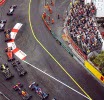
The sport of Formula One has come a long way since the deaths of Ayrton Senna and Roland Ratzenberger. The tragic fatalities prompted a thorough safety review and ongoing measures to prevent the almost annual occurrence of such tragedies in the Formula 1. Since then, the sport has seen significant changes in safety measures that have helped keep drivers safer than ever before.
Head and Neck Protection: A Critical Priority in Formula One Racing.
One of the principal safety priorities in F1 is the protection of the head and neck, as these injuries can be fatal in the short time before on-track medical personnel can attend. Modern helmets are subject to rigorous testing and made of advanced materials like carbon fiber, Kevlar, and polyethylene. In 2003, F1 made Head and Neck Support (HANS) devices compulsory, which prevent rapid and excessive head movement during accidents.
A Look at the Stronger and Safer Cars.
F1 cars have become safer than ever before, capable of withstanding powerful impacts. The primary safety focus is on the "survival cell," which encompasses the area in front of the engine and surrounding the driver. This cell is constructed using light but sturdy carbon fiber material, which is designed to resist both impacts and penetration by the sharp debris created in accidents. Additionally, the cockpit's opening has been expanded to prevent drivers from being trapped inside during fires.
Advances in Emergency Medicine in F1 Racing.
Emergency medicine has also improved significantly in F1. There are now paramedics on board the medical cars stationed around the circuits, and there are helicopters at every race to transport seriously injured drivers and personnel to nearby hospitals. The state-of-the-art trackside medical center has a surgeon and other staff on-site, and F1 says there are an average of 130 medical staff at each race.
Evolution of F1 Track Design for Safety.
The design of F1 tracks has undergone a significant transformation with new tracks designed since the 1990s featuring generous run-off areas at high-speed corners, in contrast to the Tamburello bend at Imola where Ayrton Senna lost his life. The trackside barriers have also greatly improved in efficacy and can now absorb most of the energy of a car crashing at high speed.

Although the progress has been slow, F1 has made significant strides in improving safety standards since its inception. It is staggering to realize how lax safety standards were in past eras, with helmets becoming compulsory only in 1953 and fireproof overalls in 1963. But thanks to the work of advocates like three-time world champion Jackie Stewart and Prof. Sid Watkins, and the tragedies of Imola 1994, F1 has come a long way in making the sport safer for drivers and personnel.

















